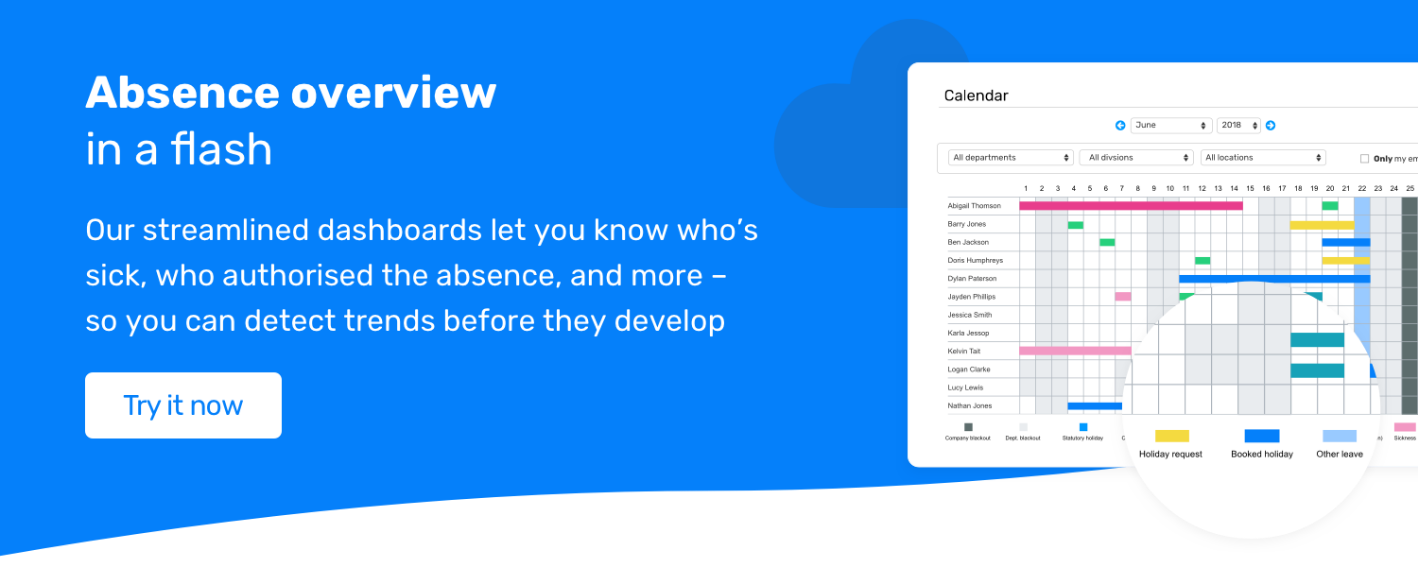Whether someone is skiving, pulling a sickie, or bunking off, taking unauthorised absence from work is a serious matter. It can cause massive headaches for managers, HR departments and those who have to pick up on the absent employee's work.
Unsurprisingly, most companies frown on unauthorised absences, which can result in disciplinary action or grounds for dismissal.
Most people recognise the strain that unauthorised absence from work puts on colleagues who have to make up the shortfall on behalf of the missing worker. Some even regard it as a kind of theft.
Whatever your view, take control by providing clear guidance via employment contracts and absence management handbooks.
What is unauthorised absence?
Unauthorised absence is where an employee fails to turn up for work without good reason and does not have permission. Unauthorised absence is also known as being 'absent without leave' - AWOL. It also covers absences where you don't believe the excuse.
An employee doesn't need to be off work for a full day for it to be classified as unauthorised absence. Lateness is sometimes categorised as unauthorised absence, especially if it is persistent or severe.
Unauthorised absence is not:
- where an employee has booked annual leave in advance;
- properly notified and genuine sickness;
- absence due to maternity/paternity leave as well as time off for antenatal care and appointments
- absence due to a statutory right, such as leave to search for work when made redundant.
It's important to recognise that unauthorised absences aren't just about an employee who 'can't be bothered' to show up. Unauthorised absences happen for a host of reasons, which may include:
- Travel problems - such as train strikes, missing the bus or even a broken down car
- Financial difficulties - an employee may be unable to afford transport to get to work
- Caring for children or other dependents - because of medical appointments, sickness or school holidays
- Undiagnosed mental health problems
- Workplace bullying or harassment
For this reason, it is especially important to follow absence management good practice.
Absence management good practice
Do the best for your business and employees by taking another look at your employee and company policies. Here's how to handle absence management the right way:
Employment contract
Plainly state what constitutes unauthorised absence in your employment contracts. Make sure you include how the company manages it and clearly define the consequences for unauthorised absence.
Absence and sickness reporting
Record and measure absence and sickness. Whether you tackle this manually or automate it via an IT system, you can use it in retrospect to pick out any patterns of absence, such as someone who might have “Monday morning syndrome”.
Choose an HR software that has a sickness management feature. Ours, at Breathe does just what it says on the tin and can help trigger actions when an unauthorised absence is recorded.

Support your employees
Make your employees aware of their rights regarding leave. Options such as parental leave and time off to care for dependents make it easier for employees with caring responsibilities to plan their time off. This in turn allows managers to ensure there is sufficient staffing in place to keep things running smoothly.
Hold return-to-work interviews
Holding interviews with an employee when they return to work after an unauthorised absence can help employee relations. Not only can you enquire after the employee's wellbeing and bring them up to speed with any company news they may have missed, but you can also determine the reasons for the absence. This will give you an opportunity to make them aware of details such as parental leave. Moreover, holding such interviews can discourage employees from taking bogus days off if they think they might be quizzed about their absence on their return.
How to handle unauthorised absence from work
How you manage an unauthorised absence may depend on the length of time taken off and how – or if - the employee has tried to justify it. For example, you may deal differently with someone who's absent for one day than you would with someone who's absent for a prolonged period.
Regardless of circumstances, remember to remain fair and consistent in your management of unauthorised absences. Explain the company process to all managers to ensure they adopt the same approach with all staff and consistency across the company.
- In the first instance, make reasonable efforts to contact the employee to determine the reason for the absence. Lack of contact from a usually reliable staff member may indicate that there is some sort of problem and that this isn’t a wilful unauthorised absence.
- You can phone their home and mobile numbers, email and text them. If you are unable to make contact, you may also try an emergency contact, if you have details on file.
- If there is still no contact, write a letter that details the unauthorised absence and requests an explanation. You can request that the staff member gets in touch within a certain time period, noting that if this does not happen, you will consider or instigate disciplinary action. Send the letter by a method that requires a signature so that you have proof of delivery. This, and all other attempts to contact the employee should be recorded as a matter of good HR practice.
- Once the employee has returned to work, meet and discuss the reasons for the absence. There may be a good reason for the absence after all, which perhaps the employee felt unable to discuss at the time. This could be a delicate medical issue, a personal or family problem, or a problem with a work colleague due to harassment or bullying. In such circumstances, the leave – although unauthorised – might be seen to be acceptable and steps can be taken to help the employee properly report absence in the future. The company can also address the issues or advise the employee how to raise a formal grievance.
Disciplinary warnings
Unauthorised absence from work is not typically classed as gross misconduct. Employment experts usually recommend that it should be handled with a succession of warnings; if these are ignored, the employee will need to attend a disciplinary hearing.
Disciplinary hearing
You can hold a disciplinary hearing if:
- You do not have an adequate explanation for the absence
- Your staff member has failed to show up for work after some days
- Your previous disciplinary warnings have gone unheeded.
Make sure you follow your company’s procedures for holding this hearing.
You can hold a disciplinary hearing in the absence of the staff member, as long as you have given them reasonable notice and are certain that they have received this. Explain that the absence was unauthorised and why that is so. If you believe that the employee’s continued unauthorised absence constitutes gross misconduct, you may dismiss them on that basis. Write to them with the outcome of the disciplinary hearing and advise them that they may appeal the decision and how they can do this.
Unauthorised absence and workplace culture
Persistent unauthorised absences in your business may indicate a problem with your company culture. Here are a few examples
- Bullying and harassment can make some employees scared or stressed about coming into work
- Employees who work long hours without thanks or with minimal pay may take unauthorised leave because they feel ‘they’ve earnt it’
- A lack of engagement may mean employees feel little responsibility towards their employer or their team and think nothing of failing to show up.
Reviewing your working practices can reduce the likelihood of unauthorised absences. Introducing the option to buy more holiday time would make school holidays easier for working parents. A well-used recognition programme may help increase engagement and feelings of self-worth. A zero-tolerance approach to bullying and harassment will make employees feel safer.
Conclusion
Absence management is an important part of the human resources role. When undertaken properly and with strong policies in place, you can protect your company against the detrimental aspects of unauthorised absence. You’ll reduce business disruption, prevent negative sentiment and low morale in the other staff, and reduce the costs associated with unauthorised absence.

Author: Laura Sands
Laura is a writer who enjoys getting into the detail of subjects and sharing that knowledge with snappy, interesting content. When not typing away, she enjoys walks in the woods and curling up with a good book and mug of something hot.
.webp)



.webp)
